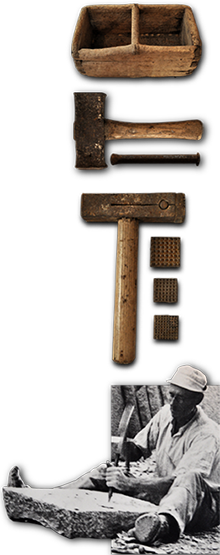|
Casa Museo dell'Alta Valle del Cervo
|
| • • |
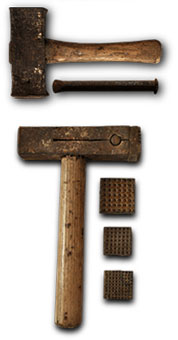
Since man’s arrival in the Valley, the alternative to the only original work which was rural, was the work of stone-cutter or builder using syenite which is a valuable type of granite as a building material and which is found in abundance in Upper Valley Cervo.
At the beginning of 1900, also as a consequence of the construction of the Biella-Balma railway, which reduced transport costs and increased the trade of larger quantities of slabs, blocks, paving cubes and pavement borders, the workers employed increased considerably to over 200 people.
After the second world war the quarries began to gradually close down. This was due to environmental problems and difficulty in accessing the sites. In the Bursch, stone remains the dominant material, not only in civil constructions but also bridges, supporting walls for terraces, in blocks and cubes for roads and even in sewage pipes.
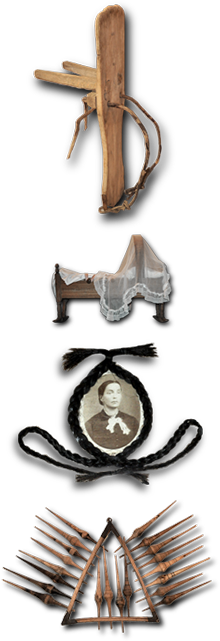
Pictures, from the top:
• "crava", used to carry cut stones on the back, straps made of copper covered in birch
• cradle
• an embroidered square sewn by a daughter in memory of her mother
• "fusera", a triangular object to hold spindles
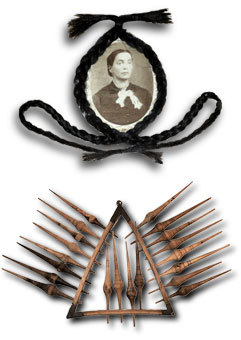
Within the family organization in the Upper Cervo Valley, the woman has always had an outstanding role. The father’s or husband’s migration obliged her to take on the double role of lone mother and worker bound to be financially independent in order to avoid using the men’s income which was to be kept aside for extraordinary expenses such as renovating the home or purchasing a piece of land. Furthermore she had to take responsibilities for those left behind and make strategic decisions concerning family life and their relationship with the other members of the community.
After attending primary school she had to take on various activities. These included house-keeping, looking after the children and the elderly and farm duties in the village or on the mountain pastures. Most importantly she was the “siunera”: in her special basket she carried heavy loads of grass after having cut it by hand with a scythe on the steepest slopes. These were the girls who also carried stone slabs and beams for the roofs of mountain huts, who removed stones from the meadows, who were responsible for the upkeep of the mule-tracks, paths and irrigation ditches and who spread manure over the pastures to make them more fertile and produce more abundant nourishing grass the following summer.
The precarious financial state of the Valley woman is witnessed by dowry papers or “bride’s burden”, written on officialised paper and undersigned by both families as a mutual commitment; they contained the detailed list and evaluation by a village expert of the poor items of clothes, mostly second-hand, and the few objects of daily use the parents had given their daughter who, most of the time was not accorded her rightful hereditary share or other guarantees.

Pictures, from top:
• fountain pen and wooden
• written record from the working men’s society of mutual aid, Campiglia Cervo
• stamp and ribbon cockade from the Rosazza working men’s society of mutual aid
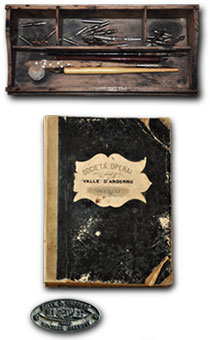
Two professional schools were established in 1862 in Campiglia Cervo and in 1869 in Rosazza. For more than a century they educated specialized technicians whose knowledge, skills, ability to adapt to the most difficult situations, capacity to face loneliness and discomfort due to sudden journeys to foreign lands and ease with which they learnt new languages made them highly appreciated everywhere.
The establishment of schools represented the highest peak of growth of the Valley community and witnessed the farsightedness of the local entrepreneurial class that, keeping up with the times and the market of expanding work, was able to evolve and improve the traditional trade with refresher courses and technical instruction. Though it may sound like a paradox, professional schools also favoured the decline of the community and the irreversible exodus of the population, thus upsetting the original balance based on the migrants’ integration of the family income. The increase in the family’s wealth made women abandon rural activity that, until then, had provided the local economy with an autonomous support, independent of profits coming from emigration. As there were no longer any reasons to remain at home, wives accompanied their men abroad; the longer their stay in foreign countries, the less frequent their visits to their ancestors’ homes became. In the last century the population decreased from 6,500 to 800 inhabitants.
At the same time as the professional schools were established, in Campiglia Cervo, Rosazza and Piedicavallo, three working men’s societies for mutual aid were created. They were formed by individuals who had the same rights and who were joined by a deep sense of brotherhood, workers were liberated from shopkeepers in their needs for the basic necessities of life thus avoiding the speculation that recent changes had brought about to the detriment of workers.
